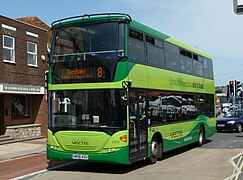
Scania AB, stylised SCANIA in its products, is a major Swedish manufacturer headquartered in Södertälje, focusing on commercial vehicles—specifically heavy lorries, trucks and buses. It also manufactures diesel engines for heavy vehicles as well as marine and general industrial applications.
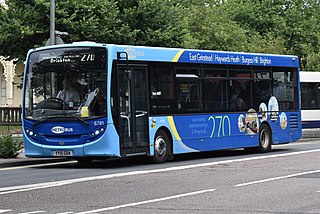
Brighton & Hove Bus and Coach Company Limited, trading as Metrobus, is a bus operator with routes in parts of Surrey, Kent, Sussex, and Greater London. Formed through a management buyout in 1983, Metrobus was purchased by the Go-Ahead Group in September 1999 and is now under the control of Brighton & Hove, part of the Go-Ahead Group.

An articulated bus, also referred to as a slinky bus, bendy bus, tandem bus, vestibule bus, stretch bus, or an accordion bus, is an articulated vehicle, typically a motor bus or trolleybus, used in public transportation. It is usually a single-decker, and comprises two or more rigid sections linked by a pivoting joint (articulation) enclosed by protective bellows inside and outside and a cover plate on the floor. This allows a longer legal length than rigid-bodied buses, and hence a higher passenger capacity (94–120), while still allowing the bus to maneuver adequately.

The Volvo B7TL is a low-floor double-decker bus chassis which was launched in 1999 and replaced the 2-axle version of the Volvo Olympian. It was built as the British bus operators seemed hesitant to purchase the B7L double decker with a long rear overhang.

The Alexander Dennis Enviro400 is a twin-axle low-floor double-decker bus that was built by the British bus manufacturer Alexander Dennis between 2005 and 2018. It replaced the Alexander ALX400, Dennis Trident and Plaxton President. In 2014, the Enviro400 was succeeded by the updated Alexander Dennis Enviro400 MMC and production of the classic Enviro400 ceased in 2018.
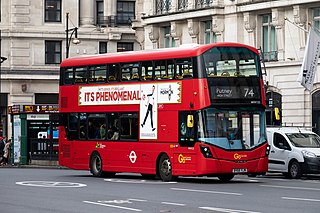
The Wright Eclipse Gemini is a low-floor double-decker bus body that was built by Wrightbus since 2001, based on the single-decker Wright Eclipse design. The second-generation Eclipse Gemini 2 was launched in 2009, followed by the third-generation Gemini 3 in 2013. Additionally, the body was available on Volvo Super Olympian chassis in Hong Kong between 2003 and 2005, marketed as the Wright Explorer.

East Lancashire Coachbuilders Limited was a manufacturer of bus bodies and carriages founded in 1934 in Blackburn, Lancashire, England. The company went into administration for a short while in August 2007, before being bought by Darwen Group and performed a reverse takeover with Optare when its parent purchased the company in 2008 and its site and business was later closed in 2012.

The Scania OmniLink is a series of integrally constructed rear longitudinal-engined low-entry city buses available on the European market. It is a complete integral product built by Scania of Sweden.

The East Lancs OmniTown was a low-floor midibus body sold in the United Kingdom by East Lancs and Scania. It used the Scania N94UB chassis, which is the single-decker version of the N94UD double-decker chassis, with East Lancashire Coachbuilders bodywork. It is sometimes mistakenly referred to as the OmniTown chassis. The confusion concerning the chassis, and indeed the buses, arises due to the complexity of the OmniTown's and other Scania products' histories.

South Notts Bus Company was a bus company operating in Nottinghamshire from 1926 until 1991 when sold to Nottingham City Transport who continue to use the brand name today.

The Scania K series is a series of chassis in Scania's city bus and coach range with longitudinally, straight-up mounted engine at the rear, replacing the K- and L-type (L94) chassis of the 4 series. The K series was first presented on Busworld 2005 in Kortrijk, Belgium, and models were available from 2006.

The Scania 4-series low floor city bus and coach range was introduced by Scania in 1997 as a successor to the 3-series bus range.

The Optare Olympus is a double-decker bus built by Optare, East Lancs and Darwen. It could be built as a body available on Alexander Dennis Enviro400, Volvo B9TL or Scania N230UD/N270UD chassis with the 2-axle and 3-axle variants. It is the double-decker equivalent of the Optare Esteem. Some 3-axle Olympus buses were built.

Articulated buses, colloquially known as "bendy buses", were rarely used in the United Kingdom compared to other countries, until the turn of the millennium. This was due to a preference for the double-decker bus for use on high capacity routes. In June 2006, there were over 500 articulated buses in the United Kingdom, although they were still heavily outnumbered by double deckers. The majority of this fleet was used in London, although these buses would be withdrawn by end of 2011.

The Alexander PS-type was a step-floor single-decker bus body built by Walter Alexander Coachbuilders in Falkirk, Scotland and was produced from 1988 to the late 1990s predominantly on the Dennis Lance, Mercedes-Benz O405, Scania N113, Volvo B10M chassis.

The Volvo B5LH is a low-floor hybrid electric bus chassis for both single-decker buses and double-decker buses manufactured by Volvo since 2008. It is the basis for Volvo's integral 7700 Hybrid full low floor city bus and its successor, the 7900 Hybrid from 2011. In 2008, pre-production batches of both types of chassis were manufactured. Serial production started in June 2010. From 2013 it is also available as an articulated bus chassis. First entering service in London, the B5LH is the only current double decker type in service in the United Kingdom that uses a parallel hybrid drive system.
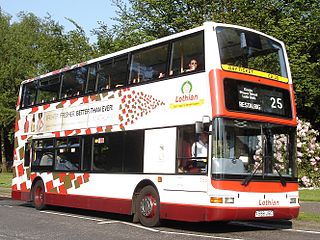
Lothian Buses is the largest provider of bus services in and around Edinburgh, the capital city of Scotland. It is entirely municipally owned, being 91% owned by the City of Edinburgh Council, with the remainder owned by Midlothian, East Lothian and West Lothian councils. Lothian Buses plc is registered in Annandale Street, Edinburgh as company number SC096849.

The East Lancs OmniDekka is a double-decker bus built for sale in the UK market, introduced by East Lancashire Coachbuilders in 2003. Originally built on Scania N94UD chassis at Euro 3, and later Scania N230UD and N270UD at Euro 4 and Euro 5, the bodywork consists of a modified East Lancs Myllennium double decker, but with the standard front end cowl and windscreen replaced with that of Scania's own integral OmniCity. Through takeovers of East Lancs, production of the OmniDekka was latterly carried out by the Darwen Group and finally Optare before ceasing in 2011.
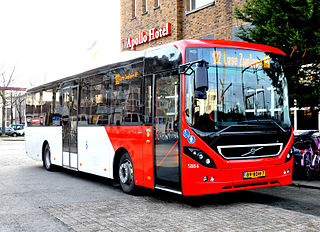
The Volvo B8RLE is a 7.7-litre-engined low-entry bus chassis manufactured by Volvo since 2013 for left-hand drive markets. It was designed as a replacement for the B7RLE and the B9RLE. The right-hand drive version was launched in November 2014.





